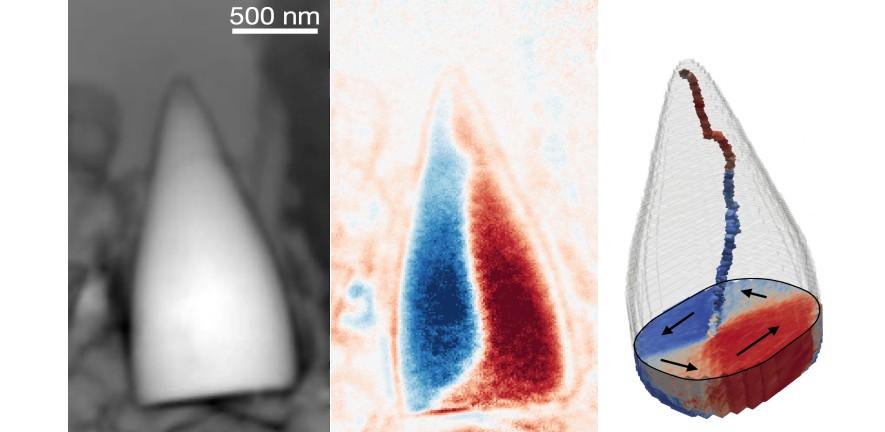
Submitted by Dr C.M. Martin-Jones on Mon, 20/10/2025 - 10:05
Buried in ancient seafloor sediments dating back millions of years lie minuscule magnetic fossils—fragments left behind by a mysterious, unidentified organism. Shaped like spearheads, spindles, bullets and needles, and no larger than a bacterial cell, scientists are confident these magnetofossils are biological in origin, but they don’t know what creature made them, or why.
Research led by the University of Cambridge and the Helmholtz-Zentrum Berlin has now solved part of the mystery, finding that these fossils may have served as an animal GPS-system, enabling organisms to read Earth’s magnetic field like a map. The researchers captured the first 3D images of the fossil’s magnetic structure, revealing features optimized to detect both the direction and strength of Earth’s magnetic field—guiding long-distance migration.
“Whatever creature made these magnetofossils, we now know it was most likely capable of accurate navigation,” said Rich Harrison from Cambridge’s Department of Earth Sciences who co-led the research.
With magnetofossils found in sediments dating back 97 million years, the discovery provides the first direct evidence that animals have been navigating using the geomagnetic field for at least this long. It may also offer insights into how animals evolved this ability, known as ‘magnetoreception’.
Magnetic sensing
Life has evolved a range of extraordinary senses, and magnetoreception is one of the most poorly understood. Birds, fish, and insects use the Earth’s magnetic field to navigate vast distances, but how they detect it is still unclear. One theory is that tiny crystals of magnetite within the body align with the Earth's magnetic field, acting like microscopic compass needles.
Certain bacteria found in lakes and water bodies worldwide possess a primitive form of magnetoreception. Chains of tiny magnetic particles inside the bacteria allow them to line up with the magnetic field, helping them swim to their preferred depth in the water column. At just 50–100 nanometres wide, these particles are the perfect compass needles, said Harrison, “if you want to create the most efficient magnetic sense, smaller is better.”
But the so-called ‘giant’ magnetofossils Harrison and the team studied are 10 to 20 times larger than the magnetic particles used by bacteria, leading some scientists to dismiss their capabilities for navigation.
Previously, some researchers had argued that giant magnetofossils may have served as protective spines. However, model simulations have suggested that they might also possess advanced magnetic properties, something Harrison wanted to explore further. “It looks like this creature was carefully controlling the shape and structure of these fossils, and we wanted to know why.”
Harrison worked closely with Sergio Valencia from Helmholtz-Zentrum Berlin in designing the research. "This was a truly international collaboration involving experts from different fields, all working together to shed light on the possible functionality of these magnetofossils,” said Valencia.
Harrison and the team applied a new technique to visualize the fossil’s internal structure, revealing how magnetic moments (tiny magnetic fields generated by spinning electrons) are arranged inside the magnetofossil.
Until now, scientists had been unable to capture 3D magnetic images of larger particles, such as giant magnetofossils, because X-rays couldn’t penetrate them.
The research was made possible using a new technique developed by study co-author Claire Donnelly at the Max Planck Institute in Germany and carried out at the Diamond X-ray facility in Oxford.
“That we were able to map the internal magnetic structure with magnetic tomography was already a great result, but the fact that the results provide insight into the navigation of creatures millions of years ago is really exciting!” said Donnelly.
"It's fantastic to see our method being used for the first time to study natural samples, which present a unique set of challenges compared to our usual fabricated ones,” said Jeffrey Neethirajan, a PhD student working in Donnelly’s lab.
Specialized for navigation
Their images revealed an intricate magnetic configuration, with magnetic moments swirling around a central line running through the fossil’s interior, forming a vortex pattern much like a tornado.
This vortex magnetism provides ideal properties for navigation, explained Harrison, generating a ‘wobble’ in response to tiny changes in the strength of the magnetic field that translate into detailed map information.
“This magnetic particle not only detects latitude by sensing the tilt of Earth’s magnetic field but also measures its strength, which can change with longitude,” said Harrison.
He added that the geometry of this vortex structure is very stable, meaning it can resist small environmental disturbances that may otherwise disrupt navigation. “If nature developed a GPS, a particle that can be relied upon to navigate thousands of kilometres across the ocean, then it would be something like this.”
Narrowing the search
In solving the enduring mystery over the fossils’ function, the work also helps narrow the search for the animal that made them. “The next question is what made these fossils,” said Harrison. “This tells us we need to look for a migratory animal that was common enough in the oceans to leave abundant fossil remains.”
He speculates that eels could be a potential candidate, having evolved around 100 million years ago and remaining one of the least understood and elusive animals. European and American eels travel thousands of kilometres from freshwater rivers to spawn in the Sargasso Sea. Though they can sense Earth’s magnetic field, how they do so remains unclear. Magnetite particles have been detected in eels but not yet imaged directly in their cells and tissues, partly because of their tiny size and the fact they could be hidden anywhere in the body.
Despite their as-yet-unknown host, “giant magnetofossils mark a key step in tracing how animals evolved basic bacterial magnetoreception into highly-specialized, GPS-like navigation systems,” Harrison said.
Reference: Harrison, R. J., Neethirajan, J., Pei, Z., Xue, P., Marcano, L., Abrudan, R., Ringe, E., Tung, P.-Y., Kuppili, V. S. C., Kaulich, B., Daurer, B. J., Colocho Hurtarte, L. C., Kazemian, M., Chang, L., Donnelly, C., & Valencia, S. . (2025) Magnetic vector tomography reveals giant magnetofossils are optimised for magnetointensity reception. Nature Communications Earth and Environment.
